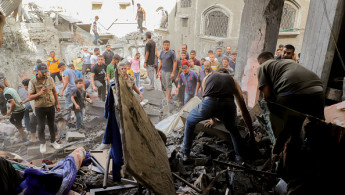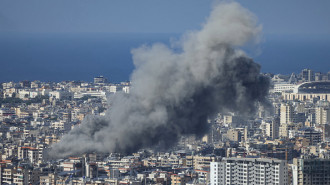Investigation reveals details of year of Israeli airstrikes with severe impact on Gaza civilians
A comprehensive investigation by UK war monitor Airwars and broadcaster Sky News has revealed the extent of Israeli airstrikes over the past year, highlighting the devastating impact on Gaza's civilian population amid the ongoing conflict.
On Wednesday, the two organisations jointly released its report, after analysing aerial footage released by the social media accounts of the Israeli military since the start of the Gaza war on 7 October.
However, the report indicated that the videos had not highlighted the total scale of destruction caused by the strikes, nor had they provided details on every location and target.
While Israel has continually defended its large-scale airstrikes on Gaza as targeting Hamas, the recent analysis revealed devastating outcomes for Palestinian civilians.
This was further supported by alternate footage on-the-ground and survivor interviews.
According to Airwars, 1,219 Israeli strikes in Gaza were documented online between 7 October 2023 and 31 August, with 531 occurring in the first month of the war.
The report further identified the geo-coordinates of 17 specific strikes, in locations where more than 400 civilians were reportedly killed.
On 13 October, an Israeli airstrike near Gaza's Al Taj residential building resulted in at least 101 deaths, including 44 children and 37 women, according to Airwars analysis.
Aerial footage of the attack was posted by the Israeli army two days later, and both Airwars and Sky News verifying the location.
Another strike on 17 October, aimed at Hamas operative Ayman Nofal in the Bureij refugee camp, killed 92 civilians, including 40 children and 28 women.
On 26 May, an airstrike targeting a refugee camp near Rafah left at least 45 dead, just days after the International Court of Justice ordered Israel to halt its operation in Rafah.
Legal experts, including Dearbhla Minogue from the Global Legal Action Network, have stressed that under international law, militaries are obligated to provide civilians with sufficient warning before an attack. This must include adequate notice and the designation of a safe area for civilians to evacuate to.
"A tunnel is not going anywhere," Minogue told Sky News, stressing that civilians should have been evacuated before a strike.
The Gaza Strip, one of the most densely populated regions in the world, poses significant challenges for precision strikes.
Conflict law expert Craig Jones noted that the highest number of civilian casualties tolerated by a Western military in a single strike during the Mosul campaign against ISIS was 50, making the toll in Gaza particularly alarming.
Many critics, including rights groups and UN officials, have accused Israel of deliberately attacking civilians or not giving due care to the loss of civilian lives in its attacks on Gaza, something that the huge civilian death toll validates.
Israel’s offensive in Gaza has resulted in the deaths of at least 42,010 people, according to Gaza's health ministry, figures which the United Nations describe as reliable.
In Lebanon, Israeli airstrikes targeting mostly the south of the country and residential areas of south Beirut have intensified since September 23, killing over 1,200 people and displacing more than a million, according to reports.




 Follow the Middle East's top stories in English at The New Arab on Google News
Follow the Middle East's top stories in English at The New Arab on Google News


![A group of Palestinians, foreign and Israeli activists gather to participated in an olive picking event on the land in the town of Battir, which is under threat of confiscation by Israel in Bethlehem, occupied West Bank on 8 November 2024. [Getty]](/sites/default/files/styles/image_330x185/public/2182930803.jpeg?h=199d8c1f&itok=__0LgGsa)